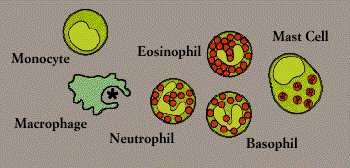Immune System Series
Phagocytes, Granulocytes, and Their Relatives
Phagocytes (literally, "cell eaters") are large white cells that can engulf and digest marauding microorganisms and other antigenic particles. Some phagocytes also have the ability to present antigen to lymphocytes.
Important phagocytes are monocytes and macrophages. Monocytes circulate in the blood, then migrate into tissues where they develop into macrophages ("big eaters"). Macrophages are seeded throughout body tissues in a variety of guises. Specialized macrophages include alveolar macrophages in the lungs, mesangial phagocytes in the kidneys, microglial cells in the brain, and Kupffer cells in the liver.

Phagocytes
Macrophages are versatile cells that play many roles. As scavengers, they rid the body of worn-out cells and other debris. Foremost among the cells that "present" antigen to T cells, having first digested and processed it, macrophages play a crucial role in initiating the immune response. As secretory cells, monocytes and macrophages are vital to the regulation of immune responses and the development of inflammation; they churn out an amazing array of powerful chemical substances (monokines) including enzymes, complement proteins, and regulatory factors such as interleukin-1. At the same time, they carry receptors for lymphokines that allow them to be "activated" into single-minded pursuit of microbes and tumor cells.
Macrophages are not the only cells to present antigen to lymphocytes. Other antigen-presenting cells include B cells, as noted above, and dendritic cells, irregularly shaped white blood cells found in the spleen and other lymphoid organs. Dendritic cells typically have long threadlike tentacles that enmesh lymphocytes and antigens. Langerhans cells are dendritic cells that travel about in the skin, picking up antigen and transporting it to nearby lymph nodes. Many other types of body cells, properly stimulated, can also be recruited to present antigens to lymphocytes.
Another critical phagocyte is the neutrophil. Neutrophils are not only phagocytes but also granulocytes: they contain granules filled with potent chemicals. These chemicals, in addition to destroying microorganisms, play a key role in acute inflammatory reactions.
Also known as polymorphonuclear leukocytes or polymorphs (because their nuclei come in "many shapes"), granulocytes include eosinophils and basophils as well as neutrophils. (The cells are named for the way they stain in the laboratory: eosinophils, for instance, have an affinity for acidic dyes such as eosin.) The phagocytic neutrophil uses its prepackaged chemicals to degrade the microbes it ingests; eosinophils and basophils typically "degranulate," releasing their chemicals to work on cells or microbes in their surroundings.
The mast cell is a noncirculating counterpart of the basophil. Located in the lungs, skin, tongue, and linings of the nose and intestinal tract, the mast cell is responsible for the symptoms of allergy (Allergy).
Another related structure is the blood platelet. Platelets, too, contain granules. In addition to promoting blood clotting and wound repair, platelets release substances that activate components of the immune system.